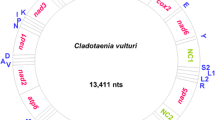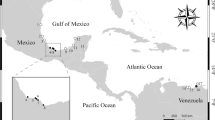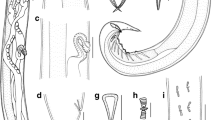Abstract
Atractolytocestus tenuicollis (Li, 1964) Xi, Wang, Wu, Gao et Nie, 2009 is a monozoic, non-segmented tapeworm of the order Caryophyllidea, parasitizing exclusively common carp (Cyprinus carpio L.). In the current work, the first molecular data, in particular complete ribosomal internal transcribed spacer 2 (ITS2) and partial mitochondrial cytochrome c oxidase subunit I (cox1) on A. tenuicollis from Niushan Lake, Wuhan, China, are provided. In order to evaluate molecular interrelationships within Atractolytocestus, the data on A. tenuicollis were compared with relevant data on two other congeners, Atractolytocestus huronensis and Atractolytocestus sagittatus. Divergent intragenomic copies (ITS2 paralogues) were detected in the ITS2 ribosomal spacer of A. tenuicollis; the same phenomenon has previously been observed also in two other congeners. ITS2 structure of A. tenuicollis was very similar to that of A. huronensis from Slovakia, USA and UK; overall pairwise sequence identity was 91.7–95.2 %. On the other hand, values of sequence identity between A. tenuicollis and A. sagittatus were lower, 69.7–70.9 %. Cox1 sequence, analysed in five A. tenuicollis individuals, were 100 % identical and no intraspecific variation was observed. Comparison of A. tenuicollis cox1 with respective sequences of two other Atractolytocestus species showed that the mitochondrial haplotype found in Chinese A. tenuicollis is structurally specific (haplotype 4; Ha4) and differs from all so far determined Atractolytocestus haplotypes (Ha1 and Ha2 for A. huronensis; Ha3 for A. sagittatus). Pairwise sequence identity between A. tenuicollis cox1 haplotype and remaining three haplotypes followed the same pattern as in ITS2. The nucleotide and amino acide (aa) sequence comparison with A. huronensis Ha1 and Ha2 revealed higher sequence identity, 90.3–90.8 % (96.9 % in aa), while lower values were achieved between A. tenuicollis haplotype and Ha3 of Japanese A. sagittatus—75.2 % (81.9 % in aa). The phylogenetic analyses using cox1, ITS2 and combined cox1 + ITS2 sequences revealed close genetic interrelationship between A. tenuicollis and A. huronensis. Independently of a type of analysis and DNA region used, the topology of obtained trees was always identical; A. tenuicollis formed separate clade with A. huronensis forming a closely related sister group.



Similar content being viewed by others
References
Anthony JD (1958) Atractolytocestus huronensis n. gen., n. sp. (Cestoda: Lytocestidae) with notes on its morphology. Trans Am Microsc Soc 77:383–390
Baruš and Oliva (1995) Mihulovci a ryby (Lampreys and Fish). Fauna Czech Slovak Republic, Academia, Praha 28:234–261 (in Czech)
Bazsalovicsová E, Králová-Hromadová I, Štefka J, Scholz T, Hanzelová V, Vávrová S, Szemes T, Kirk R (2011) Population study of Atractolytocestus huronensis (Cestoda: Caryophyllidea), an invasive parasite of common carp introduced to Europe: mitochondrial cox1 haplotypes and intragenomic ribosomal ITS2 variants. Parasitol Res 109:125–131
Bazsalovicsová E, Králová-Hromadová I, Štefka J, Scholz T (2012) Molecular characterization of Atractolytocestus sagittatus (Cestoda: Caryophyllidea), monozoic parasite of common carp, and its differentiation from the invasive species Atractolytocestus huronensis. Parasitol Res 110:1621–1629
Bruňanská M, Nebesářová J, Oros M (2011) Ultrastructural aspects of spermatogenesis, testes, and vas deferens in the parthenogenetic tapeworm Atractolytocestus huronensis Anthony, 1958 (Cestoda: Caryophyllidea), a carp parasite from Slovakia. Parasitol Res 108:61–68
Chubb JC, Kirk R, Wellby, I (1996) Caryophyllaeid tapeworm Atractolytocestus huronensis Anthony, 1958 (=Markevitschia sagittata Kulakovkaya et Akhmerov, 1965) in carp Cyprinus carpio L. in British Isles—another translocation? In: Abstract of the Spring Meeting of the British Society of Parasitology, University of Wales, 1996, p. 66
Cunningham CO (1997) Species variation within the internal transcribed spacer (ITS) region of Gyrodactylus (Monogenea: Gyrodactylidae) ribosomal RNA genes. J Parasitol 83:215–219
Darriba D, Taboada GL, Doallo R, Posada D (2012) jModelTest 2: more models, new heuristics and parallel computing. Nature Methods 9(8):772
Demshin NI, Dvoryadkin VA (1981) The development of Markevitschia sagitatta (Cestoidea: Caryophyllidae), a parasite of the Amur wild carp, in the external medium and in the intermediate host. Parazitologiya 15:113–117
Gjurcević E, Bambir S, Beck A (2009) Atractolytocestus huronensis Anthony, 1958 from farmed common carp in Croatia. In: 14th EAFP International Conference, Abstract Book. Diseases of fish and shellfish, Prague, Czech Republic
Goloboff P, Farris S, Nixon K (2000) TNT (Tree analysis using New Technology) (BETA) Published by the authors. Tucumán, Argentina
Gouy M, Guindon S, Gascuel O (2010) SeaView version 4: a multiplatform graphical user interface for sequence alignment and phylogenetic tree building. Mol Biol Evol 27:221–224
Guindon S, Dufayard JF, Lefort V, Anisimova M, Hordijk W, Gascuel O (2010) New algorithms and methods to estimate maximum-likelihood phylogenies: assessing the performance of PhyML 3.0. Syst Biol 59:307–321
Heled J, Drummond AJ (2010) Bayesian inference of species trees from multilocus data. Mol Biol Evol 27:570–580
Hoffman GL (1999) Parasites of North American freshwater fishes, Secondth edn. Comstock Publishing, London, 539 pp
Huelsenbeck JP, Ronquist F (2001) MRBAYES: Bayesian inference of phylogenetic trees. Bioinformatics 17:754–755
Jones AW, Mackiewicz JS (1969) Naturally occurring triploidy and parthenogenesis in Atractolytocestus huronensis Anthony (Cestoidea: Caryophyllidea) from Cyprinus carpio L. in North America. J Parasitol 55:1105–1118
Kappe A, Seifert T, El-Nobi G, Bräuer G (2006) Occurrence of Atractolytocestus huronensis (Cestoda: Caryophyllaeidae) in German pond-farmed common carp Cyprinus carpio. Dis Aquat Organ 70:255–259
Kirk RS, Veltkamp CJ, Chubb JC (2003) Identification of Atractolytocestus huronensis (Caryophyllidea: Lytocestidae) from carp (Cyprinus carpio) using histological and ashing techniques. Abstract of the Spring Meeting of the British Society of Parasitology, Manchester, pp 45–46
Králová-Hromadová I, Scholz T, Shinn AP, Cunningham CO, Wootten R, Hanzelová V, Sommerville C (2003) A molecular study of Eubothrium rugosum (Batsch, 1786) (Cestoda: Pseudophyllidea) using ITS rDNA sequences, with notes on the distribution and intraspecific sequence variation of Eubothrium crassum (Bloch, 1779). Parasitol Res 89:473–479
Králová-Hromadová I, Stefka J, Spakulová M, Orosová M, Bombarová M, Hanzelová V, Bazsalovicsová E, Scholz T (2010) Intraindividual ITS1 and ITS2 ribosomal sequence variation linked with multiple rDNA loci: a case of triploid Atractolytocestus huronensis, the monozoic cestode of common carp. Int J Parasitol 40:175–181
Králová-Hromadová I, Bazsalovicsová E, Oros M, Scholz T (2012) Sequence structure and intragenomic variability of ribosomal ITS2 in monozoic tapeworms of the genus Khawia (Cestoda: Caryophyllidea), parasites of cyprinid fish. Parasitol Res 111:1621–1627
Kulakovskaya OP, Akhmerov AC (1965) Markevitschia sagittata n. gen. n. sp. (Cestoda, Lytocestidae) from common carp in the Amur River. In: Parasites and parasitoses of man and animals. Naukova Dumka, Kiev, pp 264–271 (in Russian)
Lavikainen A, Haukisalmi V, Lehtinen MJ, Laaksonen S, Holmström S, Isomursu M, Oksanen A, Meri S (2010) Mitochondrial DNA data reveal cryptic species within Taenia krabbei. Parasitol Int 59:290–293
Li MM (1964) A new genus and three new species of cestodes (Caryophyllaeidae) from Cyprinus carpio in China. Acta Zootax Sin 1:355–366
Mabuchi K, Senou H, Nishida M (2008) Mitochondrial DNA analysis reveals cryptic large-scale invasion of non-native genotypes of common carp (Cyprinus carpio) in Japan. Mol Ecol 3:796–809
Majoros G, Csaba G, Molnár K (2003) Occurrence of Atractolytocestus huronensis Anthony, 1958 (Cestoda: Caryophyllaeidae), in Hungarian pond-farmed common carp. Bull Eur Assoc Fish Pathol 23:167–175
Oros M, Hanzelová V, Scholz T (2004) The cestode Atractolytocestus huronensis (Caryophyllidea) continues to spread in Europe: new data on the helminth parasite of the common carp. Dis Aquat Organ 62:115–119
Oros M, Králová-Hromadová I, Hanzelová V, Bruňanská M, Orosová M (2011) Atractolytocestus huronensis (Cestoda): a new invasive parasite of common carp in Europe. In: Carp: habitat, management and diseases. Nova Science Publisher, USA, pp 63–94
Pongratz N, Storhas M, Carranza S, Michiels NK (2003) Phylogeography of competing sexual and parthenogenetic forms of a freshwater flatworm: patterns and explanations. BMC Evol Biol 3:23
Rambaut A, Drummond A (2005) Tracer. http://tree.bio.ed.ac.uk/software/tracer/
Scholz T, Shimazu T, Olson PD, Nagasawa K (2001) Caryophyllidean tapeworms (Platyhelminthes: Eucestoda) from freshwater fishes in Japan. Folia Parasitol 48:275–288
Scholz T, Brabec J, Králová-Hromadová I, Oros M, Bazsalovicsová E, Ermolenko A, Hanzelová V (2011) Revision of Khawia spp. (Cestoda: Caryophyllidea), parasites of cyprinid fish, including a key to their identification and molecular phylogeny. Folia Parasitol 58:197–223
Špakulová M, Orosová M, Mackiewicz JS (2011) Cytogenetics and chromosomes of tapeworms (Platyhelminthes, Cestoda). Adv Parasitol 74:177–230
Telford MJ, Herniou EA, Russell RB, Littlewood DT (2000) Changes in mitochondrial genetic codes as phylogenetic characters: two examples from the flatworms. Proc Natl Acad Sci USA 9:11359–11364
Thai BT, Burridge CP, Pham TA, Austin CM (2004) Using mitochondrial nucleotide sequences to investigate diversity and genealogical relationships within common carp (Cyprinus carpio L.). Anim Genet 36:23–28
Thompson JD, Higgins DG, Gibson TJ (1994) CLUSTAL W: improving the sensitivity of progressive multiple sequence alignment throughout sequence weighting, position specific gap penalties and weight matrix choice. Nucleic Acids Res 22:4673–4680
Verneau O, Renaud F, Catzeflis F (1997) Evolutionary relationships of sibling tapeworm species (Cestoda) parasitizing teleost fishes. Mol Biol Evol 14:630–636
Via S (2001) Sympatric speciation in animals: the ugly duckling grows up. Trends Ecol Evol 16:381–390
Xi BW, Wang GT, Wu SG, Gao D, Nie P (2009) New record of genus Atractolytocestus in China with redescription of A. sagittatus (Cestoda, Caryophyllidea) from Cyprinus carpio. Acta Zootax Sin 34:407–410
Xi BW, Oros M, Wang TG, Scholz T, Xie J (2013) Khawia abbottinae n. sp. (Cestoda: Caryophyllidea) from the Chinese false gudgeon Abbottina rivularis (Cyprinidae: Gobioninae) in China: morphological and molecular data. Folia Parasitol 60:141–148
Acknowledgments
M. O. greatly appreciates Dr. Xi Bing Wen (Freshwater Fisheries Research Centre, Wuxi, China) for invaluable help during material collection. This study was financially supported by the Grant Agency of the Slovak Republic (projects VEGA 2/0014/10 and 2/0129/12), by the Slovak Research and Development Agency under contract APVV-0653-11, by the Czech Science Foundation (project P505/12/G112), and by the Institute of Parasitology (RVO: 60077344). The study was realised as part of the project “Centre of Excellence for Parasitology” (Code ITMS: 26220120022), based on support of the Operational Programme “Research & Development” funded from the European Regional Development Fund (rate 0.1).
Author information
Authors and Affiliations
Corresponding author
Additional information
Note: Nucleotide sequence data reported in this paper are available in the GenBank™, EMBL and DDBJ databases under the accession numbers KC834609-KC834634.
Rights and permissions
About this article
Cite this article
Králová-Hromadová, I., Štefka, J., Bazsalovicsová, E. et al. The tapeworm Atractolytocestus tenuicollis (Cestoda: Caryophyllidea)—a sister species or ancestor of an invasive A. huronensis?. Parasitol Res 112, 3379–3388 (2013). https://doi.org/10.1007/s00436-013-3516-y
Received:
Accepted:
Published:
Issue Date:
DOI: https://doi.org/10.1007/s00436-013-3516-y




